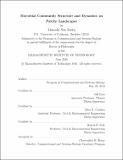Microbial community structure and dynamics on patchy landscapes
Author(s)
Datta, Manoshi Sen
DownloadFull printable version (9.607Mb)
Other Contributors
Massachusetts Institute of Technology. Computational and Systems Biology Program.
Advisor
Jeff Gore, Otto X. Cordero and Martin F. Polz.
Terms of use
Metadata
Show full item recordAbstract
Microbes are tiny metabolic engines with large-scale effects on industry, the environment, and human health. Understanding how the micron-scale actions (and interactions) of individual microbes give rise to macro-scale consequences remains a major challenge in microbial ecology. However, for the most part, studies employ coarsegrained sampling schemes, which average over the heterogeneous microscopic structure of microbial communities. This has limited our ability to establish mechanistic links between dynamics occurring across these disparate spatial scales. However, such links are critical for (a) making sense of the tremendous extant microbial diversity on Earth, and (b) predicting how perturbations (e.g., global climate change) may influence microbial diversity and function. In this thesis, I characterize the structure and dynamics of wild bacterial populations in the ocean at spatial scales of tens of microns. I then employ a simple, two-strain laboratory model system to link (cooperative) inter-species interactions at local scales to emergent properties at larger scales, focusing on spatially connected meta-communities undergoing range expansions into new territory. This work encompasses diverse environments (ranging from well-mixed communities in the laboratory to individual crustaceans) and approaches (including mathematical modeling, highthroughput sequencing, and traditional microbiological experiments). Altogether, we find that the microscale environment inhabited by a microbe - that is, "what the neighborhood is like" and "who lives next to whom" - shapes the structure and dynamics of wild microbial populations at local scales. Moreover, these local interactions can drive patterns of biodiversity and function, even at spatial scales much larger than the length of an individual cell. Thus, our work represents a small step toward developing mechanistic theories for how microbes shape our planet's ecosystems.
Description
Thesis: Ph. D., Massachusetts Institute of Technology, Computational and Systems Biology Program, 2016. This electronic version was submitted by the student author. The certified thesis is available in the Institute Archives and Special Collections. Cataloged from student-submitted PDF version of thesis. Includes bibliographical references (pages 139-156).
Date issued
2016Department
Massachusetts Institute of Technology. Computational and Systems Biology ProgramPublisher
Massachusetts Institute of Technology
Keywords
Computational and Systems Biology Program.